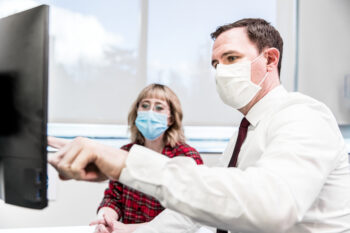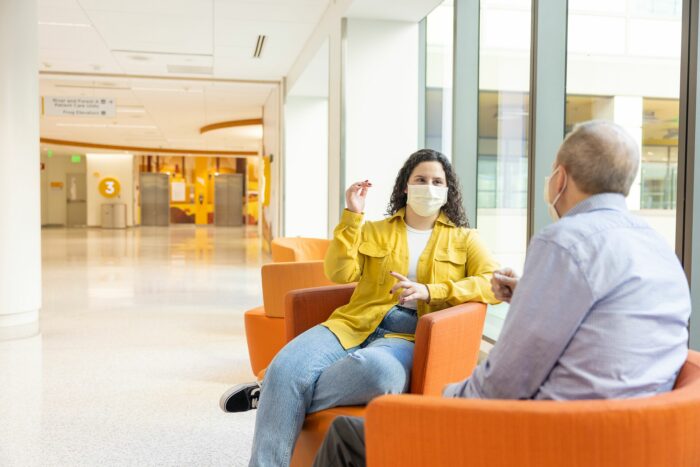9 Questions Answered about Clinical Trials by a Seattle Children’s Cancer Expert
9.14.2023 | Colleen Steelquist
 It’s estimated nearly 86,000 adolescents and young adults (AYAs) will be diagnosed with cancer this year; in fact, one-third of patients treated for cancer at Seattle Children’s are AYAs.
It’s estimated nearly 86,000 adolescents and young adults (AYAs) will be diagnosed with cancer this year; in fact, one-third of patients treated for cancer at Seattle Children’s are AYAs.
These 15- to 39-year-olds face the unique challenges of their life stage — finishing high school or college, starting a career, establishing independence, finding a romantic partner and more — with the added pressure of cancer thrown into the mix.
Unfortunately, AYAs have the lowest clinical trial participation rate of all age groups and slower progress in survival improvement than younger and older patients.
Clinical trials are controlled, scientific studies that test the safety and effectiveness of specific therapeutic interventions. They could involve a new drug, a different way of administering chemotherapy or a new surgical technique.
Clinical trials are the rigorous way to determine whether a new drug works or whether a change in treatments or procedures provides additional benefit or fewer side effects. There are also clinical trials looking at ways to describe and provide interventions for late effects after cancer therapy. Lack of representation in such trials is a huge barrier for progress in AYA cancer.
Cancer care is always changing, based on evidence. Nearly everything doctors have learned about treating cancer has come from clinical research and clinical trials. Without AYAs in the mix, it takes longer to advance medical knowledge and improve patient care.
Also, clinical trials often collect biological specimens to study the problem in the laboratory and to learn more about the basic biology and what might work for therapy. Fewer specimens equal slower progress toward cures.
 The National Comprehensive Cancer Network guidelines for AYA oncology recommend that AYA patients be encouraged to enroll in clinical trials as appropriate because of the substantial knowledge gaps in AYA cancer treatment. Improving cancer survival at all ages is directly tied to clinical trial activity.
The National Comprehensive Cancer Network guidelines for AYA oncology recommend that AYA patients be encouraged to enroll in clinical trials as appropriate because of the substantial knowledge gaps in AYA cancer treatment. Improving cancer survival at all ages is directly tied to clinical trial activity.
On the Pulse asked Dr. Tyler Ketterl, medical director of Seattle Children’s programs in Adolescent and Young Adult Oncology and Comprehensive Fertility Care and Preservation, to explain the basics of cancer clinical trialsSeattle Children’s cancer leaders head numerous national pediatric cancer steering committees, clinical trials and research consortiums in various areas including leukemia, solid tumors, brain tumors and survivorship
Who can participate in a cancer clinical trial?
Dr. Ketterl: Clinical trials have specific eligibility criteria based on factors like age, type of cancer, stage of disease, and overall health. Your medical team will determine if you meet the criteria and whether a trial is a suitable option for you.
What does a clinical trial phase mean? Should patients avoid early-stage studies?
Dr. Ketterl: Clinical trials have different phases, each serving a unique purpose in the research process. Early-stage trials focus on safety and dosing, while later stages assess effectiveness. Patients should not necessarily avoid early-stage studies; participation decisions should be based on individual circumstances and discussions with medical experts.
Why are AYAs often underrepresented in clinical trials, and why is it important to change this?
Dr. Ketterl: The low numbers of AYAs in clinical trials is due to various factors, including awareness, geographical barriers, communication gaps and lack of prioritization by healthcare institutions, to name a few. Increasing AYA participation is vital to tailoring treatments for this age group, as responses can differ from pediatric or adult patients. Additionally, increased AYA clinical trial participation may help improve survival rates, reduce late effects, improve quality of life, as well as accelerate treatment advances and access to innovative therapies.
Why might AYA patients consider a clinical trial?
Dr. Ketterl: Clinical trials can offer access to cutting-edge treatments, provide personalized care and contribute to advancing medical science. For AYAs, trials can provide tailored approaches that better align with their unique needs and challenges. Additionally, it may help provide valuable information or specimens that will improve the care for other individuals with cancer in the future.
How do you and other Seattle Children’s providers talk to patients and their families about clinical trials?
Dr. Ketterl: We have open discussions, explaining the trial’s purpose, potential benefits, risks and what participation involves. This allows patients and families to make informed decisions aligned with their goals. We also discuss standard care and how a clinical trial might differ from our standard treatment.
Does Seattle Children’s offer clinical trials not found elsewhere?
Dr. Ketterl: Yes, Seattle Children’s is at the forefront of pediatric and AYA oncology research. We often participate in national and international trials, providing access to innovative treatments that might not be available elsewhere. Through our leadership in the Children’s Oncology Group (COG) — a worldwide partnership of cancer researchers — Seattle Children’s has more open COG trials than 98% of pediatric academic medical centers. Additionally, we have trials originating at Seattle Children’s that may not be found elsewhere.
What are some risks and benefits of being in a clinical trial?
Dr. Ketterl: The benefits of participating in a clinical trial can include access to advanced treatments, state-of-the-art diagnostic testing and contributing to medical progress. Risks might involve unknown side effects, increased time spent at the hospital and the potential that newer therapies may not work as well as standard therapies. Medical teams ensure patients understand both sides before making decisions.
Are patients in clinical trials “guinea pigs”?
Dr. Ketterl: No, patients in clinical trials are not guinea pigs. Trials are conducted under strict ethical and regulatory guidelines to prioritize patient safety and well-being. Clinical trials follow rigorous protocols to ensure patient safety. Institutional Review Boards (IRBs) oversee each trial, and patient privacy is protected by adhering to strict confidentiality measures.
Who is in charge of a patient’s care during a clinical trial, and who covers the costs?
Dr. Ketterl: The oncology team, led by a cancer doctor (oncologist), is responsible for patient care during a trial. Regular monitoring ensures the patient’s health is closely watched throughout the study. Many clinical trial costs that are part of routine care for anyone with cancer are often covered by the trial sponsor or by the patient’s insurance. The medical team helps patients and their families understand the financial aspects and navigate insurance matters.
If you’d like to discuss cancer clinical trial options, email [email protected]